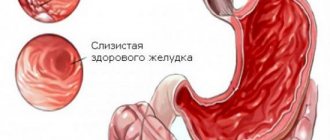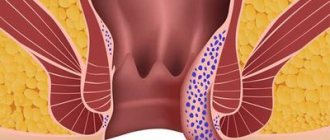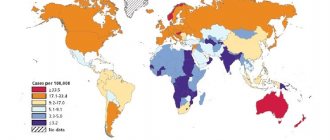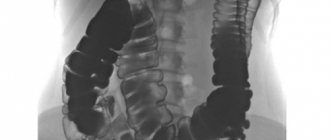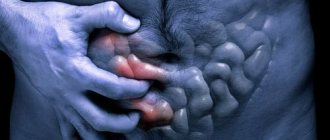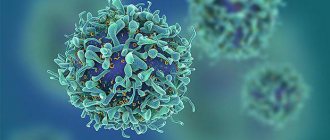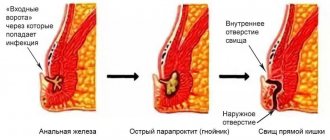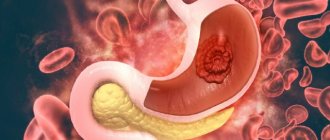General information
Cholecystopancreatitis is a disease characterized by a combination of inflammatory processes of the gallbladder and pancreas.
This disease is one of the most common gastrointestinal ailments. The code for cholecystopancreatitis according to MBK-10 is K86.8.2. The disease is characterized by pain in the right and left hypochondrium, epigastrium, prolonged vomiting and other characteristic symptoms. The main reason for this problem is determined by the close anatomical and physiological connection between these two organs. Consequently, if one of these organs is affected, then there is a possibility of the pathological process spreading to the second organ. In addition, in acute cholecystopancreatitis, the liver is involved in the pathological process. Dystrophic and necrotic disorders can occur in this organ.
Chronic cholecystopancreatitis, treatment methods
A combination of direct and indirect examinations allows us to create a picture of the disease, its stage and the severity of the patient’s condition. Based on the results of all the results, treatment is prescribed, which continues for a long time. When treating, adhere to the following principles:
- Restoring normal internal and external functioning of the pancreas.
- Relieving inflammatory processes in the gland.
- Elimination of the consequences of complications.
- Normalization of the patient’s life, development of proper diet and rest.
This video will tell you about chronic cholecystitis and cholelithiasis:
https://www.youtube.com/watch?v=C9JmXx1zbyg
Pathogenesis
of the papilla of Vater fails , then at a certain moment pathological changes occur in the other organ. The mechanism of manifestation of cholecystopancreatitis is associated with a violation of the passage of bile and pancreatic juice into the duodenum. If this process occurs normally, then the return of secretion does not occur due to the functioning of the sphincters of the pancreatic and common bile duct. If intraductal hypertension develops due to dyskinesia of the sphincter of Oddi or mechanical obstruction of the papilla of Vater, bile begins to flow into the pancreatic duct.
As a consequence, there is activation of phospholipase and other pancreatic enzymes. The components of bile form highly toxic substances that gradually destroy the organ.
Less frequently recorded are cases where in patients with pancreatitis enzymes are thrown into the bile ducts, which provokes the manifestation of cholecystitis .
An additional factor is also noted, which is the spread of pathogenic flora by hematogenous , reflux and lymphogenous routes.
Acute forms of the disease are characterized by a catarrhal or purulent-necrotic inflammatory process, while chronic forms are characterized by a fibrous-degenerative process.
Pancreas and gallbladder
Classification
When systematizing the forms of the disease, the peculiarities of its course and the nature of histological changes are taken into account.
Taking into account the main morphological changes, the following forms of cholecystopancreatitis are determined:
- purulent;
- exudative;
- necrotic-destructive;
- atrophic.
Depending on the nature of the disease, the following types of disease are determined:
- Acute cholecystopancreatitis - develops abruptly if mechanical obstruction or severe nutritional disturbances occur. The acute type of the disease is characterized by severe pain and regurgitation syndromes. This is a dangerous condition, since in the absence of proper therapy, mortality can be up to 55%.
- Chronic cholecystopancreatitis - this disease develops gradually. In this case, dyspeptic symptoms and a feeling of discomfort in the subcostal and epigastric areas are noted. Since gradual degeneration of the pancreas occurs, digestive processes are disrupted, and this phenomenon gradually progresses. The disease code according to ICD-10 is K86.8.2.
- Chronic recurrent cholecystopancreatitis - as a rule, this condition develops against the background of an acute form of the disease, less often - due to a previous persistent course.
Causes
Combined inflammation of the pancreas and gallbladder occurs against the background of initial damage to one of the organs. In approximately 85% of cases, the disease develops against the background of cholecystitis, in 15% the process begins in the pancreas, after which it is complicated by secondary enzymatic cholecystitis. The development of cholecystopancreatitis is determined by the action of the following factors:
- Mechanical obstruction of the papilla of Vater - if the pathways for the secretion of bile and pancreatic juice are blocked, biliary stagnation is noted. As a result, too much intestinal flora accumulates in the gallbladder, and the organ becomes inflamed. The intraductal pressure in the pancreatic gland also increases, and its own enzymes enter the tissue, which leads to inflammatory and destructive disorders.
- Dysfunction of the sphincter of Oddi - with constant irritation by small stones, dyskinesia of the smooth muscles of the papilla of Vater develops. Due to biliary-pancreatic and pancreato-biliary reflux, bile enters the pancreas. Pancreatic enzymes also enter the bile ducts. Intraductal hypertension against the background of hypertonicity of the sphincter of Oddi is an aggravating factor.
As for the immediate causes of the disease, the most common of them are:
- infectious diseases;
- diabetes;
- impaired metabolism;
- stomach ulcer;
- cholelithiasis;
- inflammatory processes in the gallbladder;
- parasite infection;
- oncological processes.
The development of this disease is provoked by poor nutrition, as well as bad habits. Those who smoke a lot and consume alcohol frequently and in large quantities significantly increase the likelihood of developing cholecystopancreatitis.
Inflammatory processes in the pancreas and gall bladder are possible due to uncontrolled use of medications.
The provoking factor is stress and strong emotional stress.
Another factor that can provoke this disease is the presence of foci of bacterial infection in the body. Even chronic sinusitis or caries can lead to the development of cholecystopancreatitis.
Causes and symptoms of the disease
Gallstone disease can cause the development of cholecystopancreatitis.
Inflammation of the gallbladder is provoked by the following reasons:
- disruption of the movement of bile along the bile ducts;
- bile stagnation;
- irregularity in eating;
- the presence of parasites in the body;
- entry of gland juice into the bile ducts.
Pancreatitis occurs if there are reasons such as:
- eating fatty foods;
- alcohol consumption;
- taking medications without a doctor's prescription;
- insufficient protein intake;
- disruption of vascular blood supply;
- organ pathology (tumor, scars).
The development of chronic cholecystopancreatitis is influenced by the following factors:
- increased acidity;
- cholelithiasis;
- peptic ulcer pathology of the stomach;
- cancerous tumors of the gland;
- tumor inclusions of the gastrointestinal tract.
Pancreatitis develops against the background of chronic gallbladder disease and vice versa. In the acute stage of the disease, a decrease in body weight, stool instability, bloating, and the presence of fatty inclusions in the stool are observed.
A rash occurs on the skin, and the skin around the navel appears blue. Painful palpation of the pancreas area and the presence of a compaction. Necrosis of the abdominal muscles is common.
Lack of food enzymes in the chronic course of the disease leads to loose, whitish stools and the presence of undigested food fibers in the stool. There is a blockage of the duodenal duct.
Symptoms of cholecystopancreatitis
Clinical symptoms of chronic cholecystopancreatitis can be very diverse and manifest themselves as signs of inflammation of the pancreatic gland and inflammation of the gallbladder. Like the acute type of the disease, chronic cholecystopancreatitis is manifested by pain in the abdomen, which is localized in the epigastric region or hypochondrium. In the acute form, the pain intensifies after a person eats fatty foods or drinks alcohol. Repeated vomiting is also likely, in which bile impurities are detected. But it does not bring relief to the patient.
Also, as the disease develops, the following symptoms appear:
- dyspeptic manifestations - nausea, belching, bitterness in the mouth, feeling of heaviness in the stomach;
- bowel dysfunction - stool becomes discolored, contains undigested food, bowel movements become more frequent up to several times a day;
- urine becomes dark in color;
- The sclera, skin and mucous membranes may turn yellow;
- Insomnia may occur due to constant pain ;
- During an exacerbation, fever , decreased blood pressure and a feeling of general weakness are observed.
In general, the symptoms of this disease are similar to those of other diseases of the digestive system. In the chronic form, periods of remission and exacerbations are observed. During exacerbations of the disease, the liver is enlarged, which the doctor determines during palpation.
In the obstructive form of the disease, which is very severe, the pancreatic ducts are blocked and digestive processes are disrupted. As a result, other organs of the gastrointestinal tract become inflamed.
Some patients experience rare symptoms of this disease. These include:
- ascites;
- damage to small vessels;
- false cysts.
Drug treatment for adults
The first method of treatment is medication. The patient is prescribed medications to reduce pain and inflammation:
- analgesics;
- antibiotics - they are used for cholecystopancreatitis to eliminate pathological microflora;
- enzymes and drugs that improve digestion;
- drugs to reduce pancreatic secretion;
- probiotics to restore beneficial microflora.
Most drugs are used only during the period of exacerbation, some can also be used in the chronic form. It is recommended to add mineral water to medications, which has a positive effect on digestion and metabolism (as prescribed by a doctor).
Tests and diagnostics
A specialist may suspect cholecystopancreatitis if the patient complains of typical manifestations and has certain physical symptoms. But in order to confirm the diagnosis, a comprehensive examination is required. For this purpose, laboratory and instrumental studies are practiced. The most informative methods for making a diagnosis are the following:
- Biochemical blood test - during this laboratory test, a significant increase in direct bilirubin and alkaline phosphatase . If pancreatic necrosis is noted, the levels of AST and ALT increase. Due to insufficiency of digestion, hypoalbuminemia and dysproteinemia are detected.
- Microscopic analysis of stool - it reveals remains of food that has not been digested, starch grains and many unstriated muscle fibers. A stool test for alpha-amylase is also performed. If the content of this enzyme is increased by 3-4 times, the diagnosis is confirmed.
- Complete blood count - with exacerbation of the disease, an increase in ESR and slight leukocytosis .
- Biochemical examination of urine - urobilin and bilirubin .
- Enzyme immunosorbent blood tests - it is carried out if the patient is suspected of helminthiasis .
- Ultrasound of the abdominal organs - with this study you can determine signs of damage to the gallbladder and pancreas. The disease is characterized by the presence of swelling of the gallbladder, thickening of its walls, stones, as well as deformation of the contours of the pancreas, heterogeneity of the parenchyma.
- MRI - the study is carried out if other methods are not informative enough. Using magnetic resonance cholangiopancreatography, it is possible to study in detail the structural features of the pancreas and biliary system. Using this method, it is possible to identify cysts, areas of necrosis, pathologies of the liver and pancreas.
- Retrograde cholangiopancreatography - using this method, the pancreatic ducts and bile ducts are visualized, allows you to assess the condition of the sphincter of Oddi, and determine the diameter of the bile ducts.
- X-ray – carried out to exclude the presence of pathologies of other gastrointestinal organs.
Differential diagnosis is carried out primarily with acute appendicitis .
Diagnosis of the disease
An abdominal ultrasound is the best way to diagnose the disease.
Diagnostic methods can be: direct, indirect, stool examination for elastase (a breakdown enzyme), a special respiratory test, detection of hormonal disorders, analysis for steatorrhea (fatty and oily stools). Additionally, the following examinations are performed:
- biochemical analysis of collected blood;
- analysis for the presence of sugar in the blood;
- ultrasound examination of the abdominal cavity;
- magnetic resonance imaging;
- proteinogram.
Treatment with folk remedies
Some traditional methods can alleviate the condition during exacerbation of cholecystopancreatitis. But they should be practiced under the supervision of a doctor and only after his approval.
- Infusion of yarrow and wormwood. To prepare this remedy, you need 1 tsp. Pour 1 cup of boiling water over each herb and leave for about half an hour. Drink 1 glass twice a day on an empty stomach.
- An infusion of mint, St. John's wort and wormwood. Take 1 tsp. each type of raw material and pour 2 cups of boiling water. Leave for half an hour, drink 1 glass twice a day before meals.
- Infusion of St. John's wort, chamomile, tricolor violet, linden blossom and mint. Take 1 tsp. each herb and pour 0.75 liters of boiling water over everything. After infusing for half an hour, drink a glass of the product on an empty stomach. Drink 1 glass twice a day.
- Linseed oil. Helps cleanse the gallbladder. To do this, you regularly need to take 1 tbsp. l. oil in the morning or add it to dishes.
- Infusion of celandine. To prepare it, you need to take one part of celandine, two parts each of tansy flowers, toadflax and peppermint leaves, four parts each of dandelion roots and erect cinquefoil. The ground mixture should be poured with boiling water at the rate of one glass per tablespoon. After infusing for half an hour, the product must be strained. Drink about a third of a glass three times a day, half an hour before meals. The course of admission is three weeks.
- Corn silk tea. 1 tbsp. Pour a spoonful of the product into 1 glass of water and bring to a boil. Drink a quarter glass four times a day before meals. At the same time, follow a diet.
Diet for cholecystopancreatitis
Diet 5th table
- Efficacy: therapeutic effect after 14 days
- Duration: from 3 months or more
- Cost of products: 1200 - 1350 rubles per week
Diet Table No. 5a
- Efficacy: therapeutic effect after 5-7 days
- Time frame: 2-6 weeks
- Cost of products: 1300 - 1400 rubles per week
Since this disease is currently diagnosed quite often, doctors recommend that patients and those prone to gastrointestinal diseases practice dietary nutrition. Frequent consumption of fast food and other unnatural foods, irregular meals, overeating - all these factors ultimately lead to gastrointestinal diseases.
A proper diet is important not only for preventing exacerbations, but is also an important part of therapy.
For this purpose, a special system has been developed - therapeutic Diet No. 5 . For patients in remission, diet Table No. 5p . But in general, the principles of both diets are similar.
The basic principles of dietary nutrition are as follows:
- In case of exacerbation, fasting is indicated in the first days, after which the diet is gradually expanded.
- Meals should be fractional - 5-6 times a day. Portions are small. It is very important to chew your food thoroughly.
- You need to eat at the same time.
- Food should not be too hot or cold, the recommended temperature is about 40 degrees.
- You should only eat steamed, baked without fat, or boiled foods.
- It is necessary to exclude all foods that increase the secretion of bile and pancreatic juice - spicy, fried, salty, pickled, etc.
- It is important to exclude foods that take a long time to digest and cause increased gas formation in the intestines.
- You should limit the amount of fats and carbohydrates, but eat enough protein foods.
What can you eat on this diet?
You can eat the following foods:
- lean meat - turkey, rabbit, beef, chicken;
- dry or stale white bread, dry cookies;
- low-fat, non-acidic dairy products – cottage cheese, cheese, milk;
- dairy and vegetarian soups;
- cereals – buckwheat, semolina, oatmeal, rice;
- boiled vegetables;
- dried fruits, non-acidic fruits after heat treatment (for example, baked apples);
- one egg per day as a steamed omelet;
- jelly, weak tea, rose hip decoction, herbal tea.
What is prohibited?
You should not eat the following foods and dishes:
- baked goods, fresh bread, baked goods;
- fish and meat soup, cabbage soup, borscht, mushroom soups;
- caviar, canned food, fatty fish;
- fatty meat, sausages;
- fast food, snacks;
- spices and hot seasonings;
- fresh vegetables;
- cocoa, chocolate, confectionery;
- coffee, strong tea, soda, alcohol.
In general, the diet includes many restrictions, but it is necessary to adhere to it.
Diet for cholecystopancreatitis
Treatment methods
Mineral water will help relieve the acute form of chronic cholecystopancreatitis.
To relieve the acute form of chronic cholecystopancreatitis, it is prescribed to drink hydrocarbonate-chloride mineral water, 250 g five times a day.
A diet without fatty, spicy foods, soda and sour apples, smoked meats, marinades, strong tea and coffee is recommended. Meals should be fractional and gentle on inflamed organs. Drug treatment is as follows:
- To block pain and improve the movement of bile and pancreatic juice, antispasmodics (papaverine, duspatalin) and analgesics (injectable analgin and tramadol) are used.
- To ensure normal digestion, drugs are used - enzymes (Creon, Pancreatin), which are taken before meals.
- To reduce the production of gland secretions, medications such as omeprazole and pantoprazole are allowed.
- Antibacterial agents are used (metronidazole, azithromycin).
- To restore the intestinal microflora, they are prescribed (bifiform, hilak).
Physiotherapy is prescribed:
- laser therapy;
- low-intensity UHF procedure;
- high frequency UHF.
Procedures to relieve pain:
Consequences and complications
If treatment is not carried out promptly and correctly, the likelihood of complications increases.
In patients with cholecystopancreatitis, severe digestive insufficiency is observed, as a result of which steatorrhea and lienterea , and weight decreases significantly. If the islets of Langerhans are involved in the pathological process, pancreatogenic diabetes mellitus . If areas of the small intestine become infected, duodenitis and jeunitis .
The most common complications of this pathology are:
- bile duct obstruction;
- diseases of the endocrine system;
- thrombosis ;
- damage to peripheral nerves;
- peritonitis.
Another serious complication is pancreatic necrosis , which develops if enzymes inside the pancreatic ducts are activated. In the absence of proper treatment, this condition can lead to perforation of the organ and the release of infected contents into the abdominal cavity.
Inflammation of the gallbladder and pancreas
The patient quickly learns about the presence of the disease thanks to obvious symptoms, but the final diagnosis can only be made by a doctor after diagnosis.
Acute symptoms
In the acute form, the symptoms of cholecystopancreatitis are pronounced. The patient experiences:
- severe pain under the ribs on the right side of the body, it can spread to the back and become girdling;
- nausea and vomiting;
- flatulence and bloating;
- weight loss;
- constipation and loose stools alternately;
- belching, dryness and bitterness in the mouth;
- skin rashes and itching;
- dehydration;
- blue skin around the umbilical fossa.
Signs of a chronic process
In the absence of treatment, the acute form gradually turns into chronic cholecystopancreatitis, characterized by periods of exacerbation and remission.
An exacerbation is manifested by signs characteristic of acute cholecystopancreatitis. During the period of remission, symptoms disappear and the patient feels relatively healthy. But at the same time, negative changes occur in the body, manifested in the form of:
- yellowness of the skin;
- pain in the hypochondrium after eating certain foods;
- the appearance of a white coating on the tongue;
- formation of arthritic nodules on the hands;
- accumulation of fluid in the abdominal cavity;
- dryness and peeling of the skin.
ICD code
Chronic cholecystopancreatitis has a code according to ICD 10 - K86.8.2. The disease belongs to class 11, which includes pathologies of the digestive system and is designated by the letter K. ICD 10 codes are written using letters (from A to U) and numbers.
The designations K80-K87 encrypt diseases of the biliary tract and gall bladder. In particular, K86 stands for other diseases of the pancreas.
Sonographic picture
The diagnosis of the disease is carried out by a doctor. He examines the patient, listens to complaints and prescribes tests. The most important way to detect the disease is an ultrasound examination of the abdominal cavity. When performing it, a specialist can detect signs of cholecystopancreatitis in the form of diffuse changes in the walls of the liver and bile ducts:
- grain;
- heterogeneity;
- density;
- scarring;
- sclerosis;
- hemorrhages;
- accumulation of metabolic products and other changes in tissues.
When examining the bile ducts, their increased echogenicity is noted, and the location and condition of the blood vessels is poorly visible.
Blockage of the passage with cholecystopancreatitis In chronic cholecystopancreatitis, the echographic picture is clear. In the acute form, diffuse changes are pronounced and significantly deviate from normal values.
List of sources
- Acute cholecystopancreatitis / Zatevakhin I.I., Krylov L.B., Sabirov B.U. — 1986.
- Tactics of management and treatment of patients with cholecystopancreatitis / Dudchenko M.A. // World of Medicine and Biology – 2013 – No. 1.
- Tomashuk I.P. Biliary acute cholecystopancreatitis - K.: Health, 1992. - 184 p.
- Tomnyuk N.D., Danilina E.P., Beloborodova Yu.S., Beloborodov A.A. Modern ideas about the diagnosis and treatment of chronic pancreatitis (literature review) // Advances in modern natural science. – 2015. – No. 5. – P. 45-48;
- Zimmerman Ya.S. Chronic pancreatitis // Bulletin of the Pancreatology Club. - 2009. No. 1. - P. 38-47

